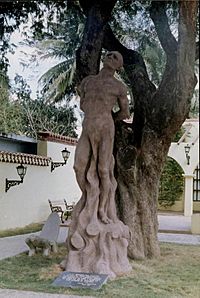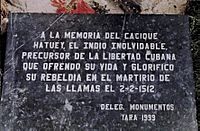Hatuey facts for kids
Quick facts for kids Hatuey I of Guahabá |
|
|---|---|

The monument of Hatuey, in Baracoa city, Cuba—the place he besieged the most while fighting the Spanish forces.
|
|
| Cacique of Guahabá | |
| Reign | 27 August 1503 - 26 April 1508 |
| Born | 6 January 1478 Quisqueya |
| Died | 2 February 1512 Baracoa, Cuba |
| Known for | Being Cuba's "first national hero." |

Hatuey (died February 2, 1512) was a brave Taíno chief. He came from the island of Hispaniola, which is now Haiti. He lived in the late 1400s and early 1500s.
Chief Hatuey became famous for leading his people against the Spanish invaders. He is known as "Cuba's First National Hero." A 2010 movie called Even the Rain shows his story.
Contents
Hatuey's Fight for Freedom
In 1511, a Spanish leader named Diego Velázquez de Cuéllar came from Hispaniola. He wanted to take over the island of Cuba. He also wanted to control the native people there, the Taíno.
But Hatuey knew what was coming. He had already escaped from Hispaniola with about 400 people. They traveled in canoes to eastern Cuba. There, he warned the local Taíno people about the Spanish.
Hatuey's Warning to His People
A priest named Bartolomé de Las Casas wrote about Hatuey's words. Hatuey showed the Taíno people a basket of gold and jewels. He told them:
"This is the god the Spanish worship. For these things, they fight and kill. For these, they hurt us. We must throw them into the sea."
He also said, "These rulers tell us they worship a God of peace. But they take our land and make us slaves. They are not as brave as us. They hide behind iron armor that our weapons cannot break."
Fighting the Spanish Invaders
Many Taíno chiefs in Cuba did not listen to Hatuey's warning. Few joined him to fight. So, Hatuey used special fighting methods. These were called guerrilla tactics. This means small groups of fighters would make surprise attacks.
Hatuey and his fighters were able to stop the Spanish for a while. They even killed at least eight Spanish soldiers. But the Spanish had dogs and tortured native people for information. In the end, they caught Hatuey.
Hatuey's Final Moments
On February 2, 1512, Hatuey was tied to a pole. He was burned alive in a place called Yara. This is near the city of Bayamo today.
Before he died, a priest asked Hatuey if he would accept Jesus. The priest said if he did, he would go to heaven. Las Casas wrote about Hatuey's answer:
Hatuey thought for a moment. Then he asked the priest if Spaniards went to heaven. The priest said yes. Hatuey then said he did not want to go there. He said he would rather go to hell. This was so he would not be where the cruel Spanish people were.
Hatuey's Lasting Legacy
Hatuey is still remembered today. A town in Cuba, south of Sibanicú, is named after him. It is called Hatuey.
His name is also used for a popular beer brand. This beer has been made in Santiago de Cuba since 1927. It was first made by a Cuban company. Later, another company took over. In 2011, the Bacardi family started making Hatuey beers again in the United States.
Hatuey is also a brand of a sweet, non-alcoholic drink called Malta. It is also a brand of soda crackers in the Dominican Republic.
The 2010 film Even the Rain was filmed in Bolivia. Hatuey is an important character in a movie shown within that film.
The logo for the Cuban cigar and cigarette brand Cohiba shows a picture of Hatuey.
Hatuey in Art
Hatuey's image has been used in many types of art. He is in an opera called "Hatuey: Memory of Fire." Many artists have used his image. These include Cuban-American artist Ric Garcia and U.S. Marine Corps artist Donald Dickson.
See also
 In Spanish: Hatuey para niños
In Spanish: Hatuey para niños
- List of Taínos
- Taíno people


